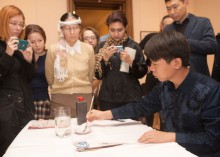The Bohdan and Varvara Khanenko National Museum of Arts is hosting an exhibition of paintings by contemporary Chinese artist Chang Peng, called “Bowing Down to the Greatness of Creations.” Among his own compositions, which are created in traditional Chinese techniques and styles, the artist presents copies of paintings done almost a thousand years ago.
“In China and other Far East countries which have experienced significant cultural influence of the Middle Kingdom, copying is an independent and self-sufficient artistic activity. Thorough imitation helps to understand the classic artists’ worldviews and the appropriateness of the techniques they used. Even more, it allows one to become a hand of flesh and blood that revives ancient works,” emphasized the curator of the exhibition, leading research fellow of the museum’s Oriental arts department Marta Lohvyn.
Traditional Chinese painting includes many currents, but according to their style, they can be divided into two large groups: the “diligent brush” and “idea painting.” The painter carefully describes the paintings on display: “This exhibition includes a dozen selected sample paintings in the genre ‘flowers and birds,’ done in the style of ‘diligent brush’ in the Song epoch (10th-13th centuries) and copied by the hand of a contemporary artist. For a painter who works in this style, it is important to show the ability to convey the smallest details of nature with lines.” That is why, according to him, it is necessary to carefully think through the composition and apply a wide range of bright, pure paints. “What was achieved by the Song painters was more than just realistic pictures, as they also managed to convey the ‘spirit and soul’ of their subjects, add new colors to nature, make it more tasteful through aesthetic design,” Chang Peng concluded.

POPPY FLOWERS / Photo replica by Mykola TYMCHENKO, The Day
It seems that the paintings on silk even breathe when no inquisitive eye is looking at them. And the impression is quite right, because all the elements – flowers, fruits, grasses, trees – are appropriate and coordinated with each other, there is no accidental line, but at the same time the paintings look dynamic and alive. The stories of depicted compositions revolve around the inner impressions left by what the artists saw, folk motifs, collision of motion and statics in one plane. All this is achieved thanks to the bright, eye-pleasing color choice, which often involves interplay of shades with which the artist easily conveys the soft spring wind, the plants’ wait for the sunlight at dawn or the concentration of an insect that prepares an ambush. The compositions which are based on the Chinese epic or folklore look movingly. Consequently, when contemplating Grasshoppers and Lush Stalks, the visitor of the exhibition will not only discover the Chinese symbols for fertility and the continuity of the bloodline, but also give a thought to the search of Ukrainian equivalents.

During the exhibition, the tools and natural minerals that were used to create these works were displayed as well. Meanwhile, for those especially sympathetic and interested in the intricacies of Chinese painting, Chang Peng held an interesting meeting and master class in creating copies of paintings by ancient masters.
The exhibition will last till October 15.








